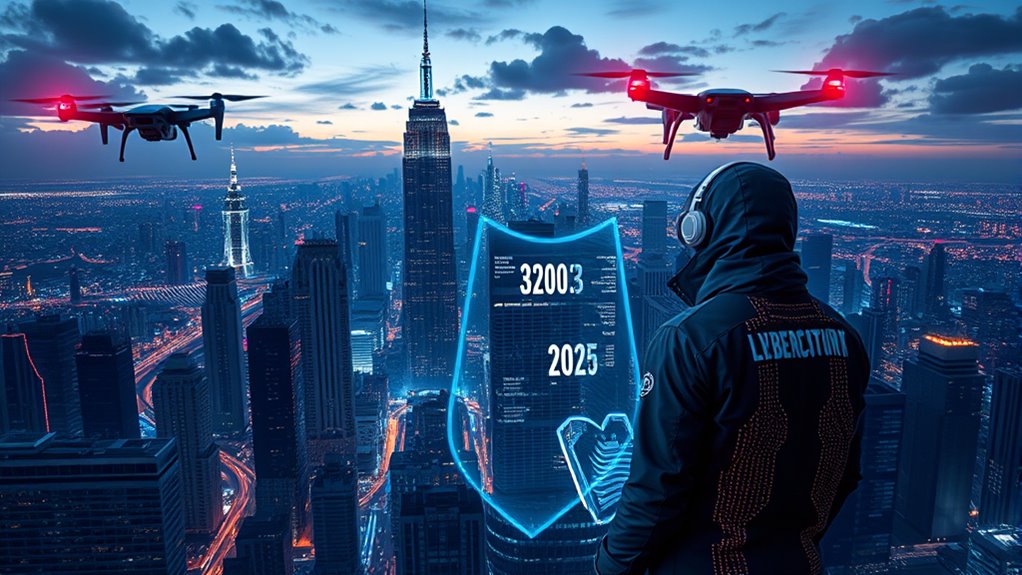By 2025, your digital safety faces growing threats from insecure IoT devices and AI-driven attacks that evolve rapidly. Hackers exploit vulnerabilities in connected gadgets, making it easier to access sensitive systems, while AI malware adapts and remains hidden longer, bypassing traditional defenses. Staying vigilant and proactive is essential to protecting your data. If you want to understand how to defend yourself better, there’s more insight ahead.
Key Takeaways
- IoT device proliferation increases attack vectors, often lacking adequate security, leading to higher risks of unauthorized access and data breaches.
- AI-driven cyberattacks are autonomous, adaptive, and more sophisticated, making traditional defenses increasingly ineffective.
- The combination of insecure IoT devices and AI malware creates complex, evolving threats that challenge detection and response efforts.
- User awareness, regular updates, strong passwords, and multi-factor authentication are vital for individual defense against emerging threats.
- Continuous vigilance, threat education, and diversification strategies, such as financial safeguards, are essential for maintaining global digital safety in 2025.

Have you ever wondered how vulnerable your digital life really is? In 2025, that concern is more valid than ever. As technology advances, so do the threats lurking in cyberspace. The proliferation of Internet of Things (IoT) devices has expanded our connected world, but it’s also introduced a new set of risks. IoT vulnerabilities are a growing concern because many devices—smart thermostats, security cameras, even medical equipment—lack robust security measures. Hackers exploit these weaknesses to gain entry into networks, often without detection. Once inside, they can pivot to more sensitive systems, causing chaos or stealing valuable data. The sheer volume of connected devices means that attackers have more entry points than ever before, making it essential for you to understand the importance of securing these devices.
Meanwhile, AI-driven attacks are transforming the cyber threat landscape. Unlike traditional hacking methods, these attacks are autonomous and adaptive, using artificial intelligence to identify vulnerabilities and craft sophisticated exploits in real time. With AI, hackers can automate reconnaissance, create convincing phishing messages, or even bypass security protocols that would have been foolproof a few years ago. These attacks are faster, more targeted, and harder to detect, making them a formidable challenge for cybersecurity defenses. For you, this means that simply installing antivirus software isn’t enough anymore. You need a layered, proactive approach to defend against AI-driven threats that evolve rapidly and adapt to your security measures.
AI-driven attacks are autonomous, adaptive, and faster—requiring layered, proactive defenses beyond basic antivirus software.
The combination of IoT vulnerabilities and AI-driven attacks creates a perfect storm. Hackers can leverage insecure connected devices to breach networks and then deploy AI-powered malware to escalate their access and stay hidden. This dynamic makes it increasingly difficult to detect and respond in time. As a user, you’re often the last line of defense, but you can’t rely solely on technology. Staying informed about these evolving threats is crucial. Regularly updating your device firmware, using strong, unique passwords, and enabling multi-factor authentication can drastically reduce your risk. Education about phishing tactics and suspicious activity also plays a vital role because attackers frequently use AI to craft convincing scams tailored to you.
Ultimately, in 2025, understanding IoT vulnerabilities and the threat of AI-driven attacks isn’t optional; it’s essential. The digital landscape is evolving rapidly, and cybercriminals are leveraging every new tool at their disposal. By being vigilant and proactive, you can better protect your digital life from these sophisticated threats. Remember, safeguarding your personal and professional information requires awareness, preparation, and continuous vigilance against the ever-changing cyber threat landscape. Additionally, understanding the importance of Gold IRA options can help diversify your assets and strengthen your financial security in uncertain times.
Frequently Asked Questions
How Will AI Change Future Cybersecurity Strategies?
AI will revolutionize your cybersecurity strategies by enabling AI-driven defense systems that adapt in real-time. You’ll benefit from adaptive threat detection, which identifies and responds to new threats faster than ever. With AI handling routine monitoring and threat analysis, you can focus on strengthening defenses and responding proactively. This shift means your cybersecurity becomes more resilient, efficient, and capable of countering evolving cyber threats effectively.
What Are Emerging Countries’ Biggest Cybersecurity Challenges?
You face significant challenges in emerging countries, especially with rising infrastructure gaps and emerging vulnerabilities. These gaps leave systems more exposed to cyberattacks, while vulnerabilities are constantly evolving with new technology deployments. To safeguard your digital assets, you need to prioritize strengthening infrastructure, updating security protocols, and training your staff. Addressing these issues proactively can help prevent breaches and ensure your cybersecurity defenses keep pace with emerging threats.
How Does Quantum Computing Threaten Current Encryption Methods?
Quantum computing threatens your current encryption methods by exposing quantum vulnerabilities that can break traditional cryptography. As quantum breakthroughs advance, they can rapidly decipher encrypted data, risking sensitive information. You need to stay ahead by adopting quantum-resistant encryption strategies. Preparing now helps safeguard your data against future quantum attacks, ensuring your digital security remains intact despite these emerging technological challenges.
What Role Do International Laws Play in Cybercrime Prevention?
International laws play a vital role in cybercrime prevention by fostering international cooperation and strengthening legal enforcement. You’re more effective when countries work together to share intelligence, establish common standards, and pursue cybercriminals across borders. These laws help create a unified front, making it harder for cybercriminals to operate with impunity. Your global efforts ensure stronger cybersecurity measures, reducing threats and protecting digital assets worldwide.
How Can Small Businesses Improve Their Cybersecurity Resilience?
A stitch in time saves nine, so for your small business, boosting cybersecurity awareness is vital. You can improve resilience by implementing strong passwords, enabling two-factor authentication, and regularly updating software. Educate your team on phishing scams, back up data consistently, and develop a clear response plan for cyber incidents. Staying proactive and informed helps shield your business from threats and builds a resilient digital environment.
Conclusion
As you navigate this interconnected world, it’s no coincidence that cybersecurity threats continue to evolve right alongside technology. Staying vigilant and informed isn’t just smart—it’s essential. Just when you think you’ve seen it all, new risks emerge, reminding you that digital safety is a constant pursuit. By understanding these threats today, you’re better equipped to protect tomorrow. After all, in this digital age, your security depends on staying one step ahead—because coincidence often hides the greatest challenges.










